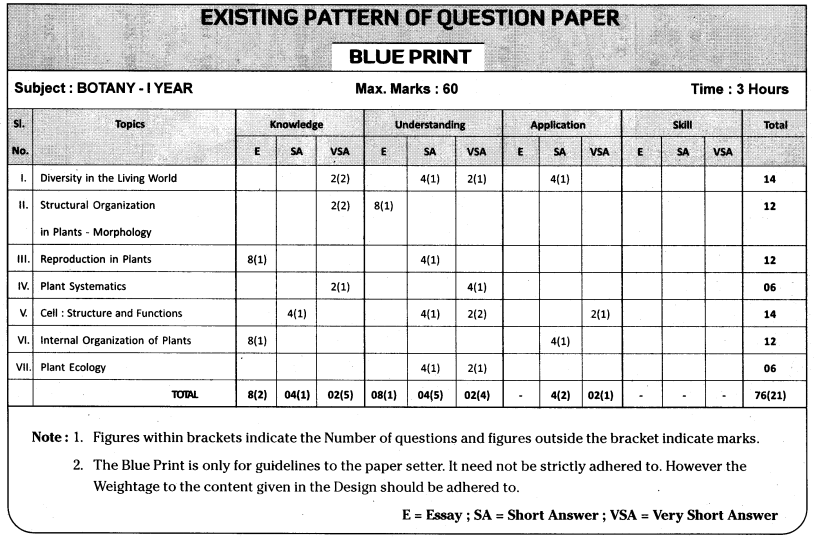Telangana & Andhra Pradesh BIEAP TS AP Intermediate Inter 1st Year Botany Study Material Textbook Solutions Guide PDF Free Download, TS AP Inter 1st Year Botany Blue Print Weightage 2022-2023, Telugu Academy Intermediate 1st Year Botany Textbook Pdf Download, Questions and Answers Solutions in English Medium and Telugu Medium are part of AP Inter 1st Year Study Material Pdf.
Students can also read AP Inter 1st Year Botany Syllabus & AP Inter 1st Year Botany Important Questions for exam preparation. Students can also go through AP Inter 1st Year Botany Notes to understand and remember the concepts easily.
AP Intermediate 1st Year Botany Study Material Pdf Download | Jr Inter 1st Year Botany Textbook Solutions
Unit I Diversity in the Living World
- Chapter 1 The Living World
- Chapter 2 Biological Classification
- Chapter 3 Science of Plants – Botany
- Chapter 4 Plant Kingdom
Unit II Structural Organisation in Plants – Morphology
Unit III Reproduction in Plants
Unit IV Plant Systematics
Unit V Cell Structure and Function
Unit VI Internal Organisation of Plants
Unit VII Plant Ecology
TS AP Inter 1st Year Botany Weightage Blue Print 2022-2023
TS AP Inter 1st Year Botany Weightage 2022-2023 | TS AP Inter 1st Year Botany Blue Print 2022

Intermediate 1st Year Botany Syllabus
TS AP Inter 1st Year Botany Syllabus
Unit I Diversity in the Living World (30 Periods)
Chapter 1 The Living World
What is living? Diversity in the living world; Taxonomic categories and taxonomical aids.
Chapter 2 Biological Classification
Five kingdom classifications – Monera, Protista, Fungi, Plantae and Animalia, Three domains of life (six kingdom classification), Viruses, Viroids, Prions & Lichens.
Chapter 3 Science of Plants – Botany
Origin, Development, Scope of Botany and Branches of Botany.
Chapter 4 Plant Kingdom
Sailent features, classification, and alternation of generations of the plants of the following groups – Algae, Bryophytes, Pteridophytes, Gymnosperms, and Angiosperms.
Unit II Structural Organisation in Plants – Morphology (20 Periods)
Chapter 5 Morphology of flowering plants
Vegetative: Parts of a typical Angiosperimic plant; Vegetative morphology and modifications – Root, stem, and leaf – types; venation, Phyllotaxy.
Reproductive: Inflorescence – Racemose, Cymose, and special types (in brief).
Flower: Parts of a flower and their detailed description; Aestivation, Placentation.
Fruits: Types – True, False, and parthenocarpic fruits.
Unit III Reproduction in Plants (25 Periods)
Chapter 6 Modes of Reproduction
Asexual reproduction, binary fission, sporulation, budding, fragmentation, vegetative propagation in plants, sexual reproduction, in brief, Overview of the angiosperm life cycle.
Chapter 7 Sexual Reproduction in Flowering Plants
Stamen, Microsporangium/pollen grain, Pistil, megasporangium (ovule) and embryo sac; development of male and female gametophytes. Pollination types, agents, outbreeding devices, and pollen- pistil interaction Double Fertilization; Post fertilization events; Development of endosperm and embryo; development of seed, the structure of Dicotyledonous and Monocotyledonous seeds, Significance of fruit and seed Special modes Apomixis, parthenocarpy, polyembryony.
Unit IV Plant Systematics (10 Periods)
Chapter 8 Taxonomy of Angiosperms
Introduction. Types of Systems of classification (In brief). Semitechnical description of a typical flowering plant description of families: Fabaceae, Solanaceae, and Liliaceae.
Unit V Cell Structure and Function (35 Periods)
Chapter 9 Cell – The Unit of Life
Cell-Cell theory and cell as the basic unit of life-overview of the cell. Prokaryotic cells, Ultra Structure of Plant cell (structure in detail and functions in brief). Cell membrane, Cell wall, Cell organelles; Endoplasmic reticulum, Mitochondria, Plastids, Ribosomes, Golgi bodies, Vacuoles, Lysosomes, Microbodies, Centrosome and centriole, Cilia, Flagella, Cytoskeleton, and Nucleus. Chromosomes: Number, structural organization; Nucleosome.
Chapter 10 Biomolecules
Structure and function of Proteins, Carbohydrates, Lipids, and Nucletic acids.
Chapter 11 Cell Cycle and Cell Division
Cell Cycle, Mitosis, Meiosis – significance.
Unit VI Internal Organisation of Plants (25 Periods)
Chapter 12 Histology and Anatomy of Flowering Plants
Tissues – types, structure, and functions: Meristematic; Permanent tissues- Simple and Complex tissues. Tissue systems – Types, structure, and function: Epidermal, Ground, and Vascular tissue systems. Anatomy of Dicotyledonous and Monocotyledonous plant-Root, stem, and leaf. Secondary growth in Dicot stem and Dicot root.
Unit VII Plant Ecology (12 Periods)
Chapter 13 Ecological Adaptations, Succession, and Ecological Services
Introduction, Plant communities and Ecological adaptations: Hydrophytes, Mesophytes, and Xerophytes. Plant succession. Ecological services – Carbon fixation, Oxygen release, and pollination (In brief).
We hope that this Telangana & Andhra Pradesh BIEAP TS AP Intermediate Inter 1st Year Botany Study Material Textbook Solutions Guide PDF Free Download 2022-2023 in English Medium and Telugu Medium helps the student to come out successful with flying colors in this examination. This Jr Inter 1st Year Botany Study Material will help students to gain the right knowledge to tackle any type of questions that can be asked during the exams.